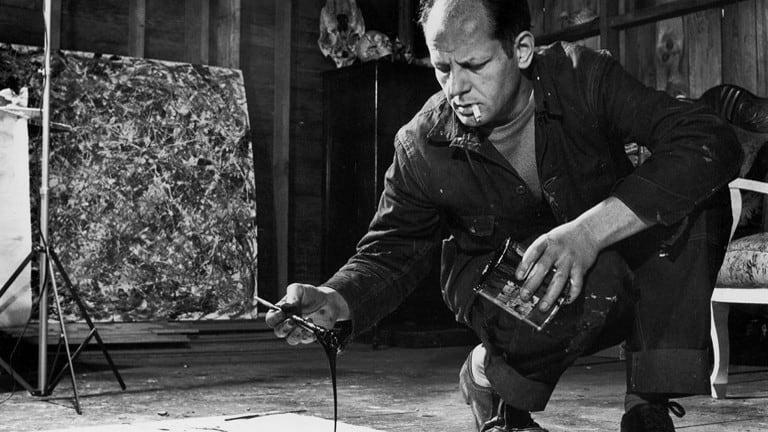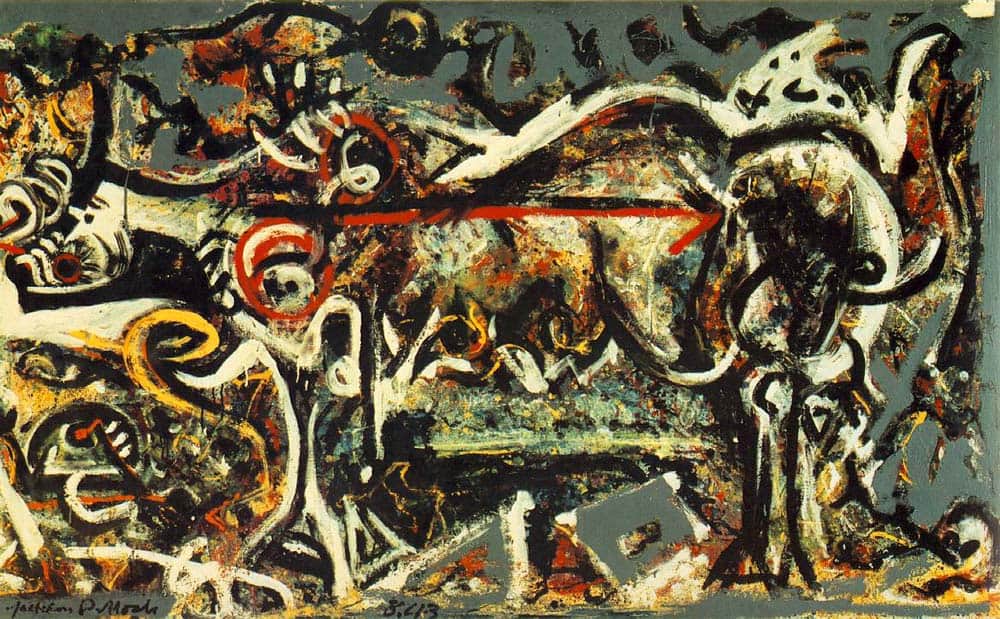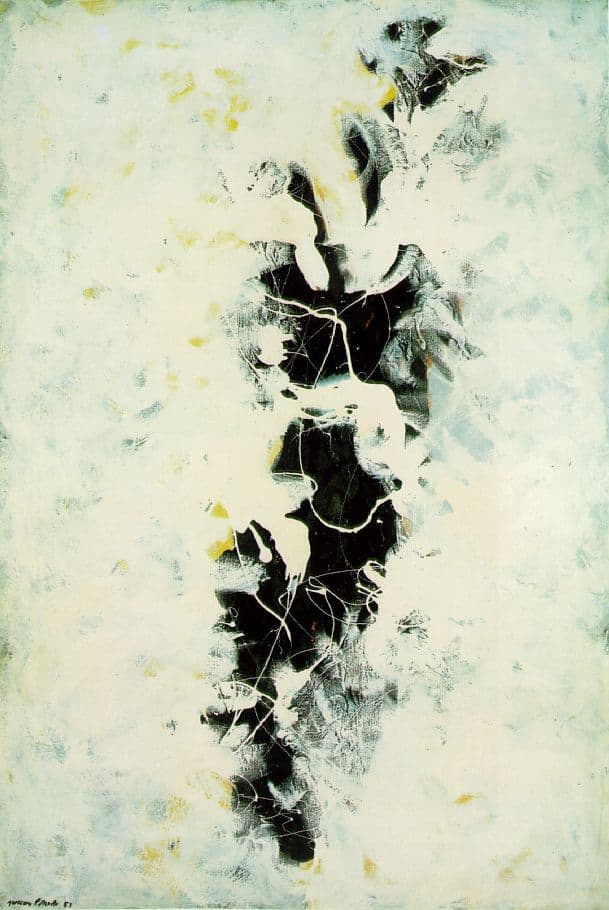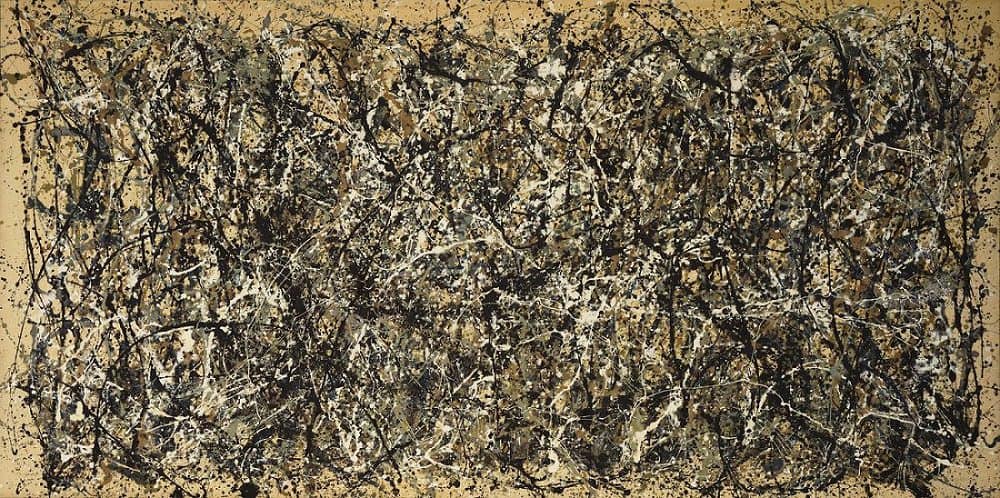Paul Jackson Pollock (January 28, 1912 – August 11, 1956), known professionally as Jackson Pollock, was an influential American painter and a major figure in the abstract expressionist movement. He was well known for his unique style of drip painting.
During his lifetime, Pollock enjoyed considerable fame and notoriety; he was a major artist of his generation. Regarded as reclusive, he had a volatile personality, and struggled with alcoholism for most of his life. In 1945, he married the artist Lee Krasner, who became an important influence on his career and on his legacy.
Pollock died at the age of 44 in an alcohol-related single-car accident when he was driving. In December 1956, four months after his death, Pollock was given a memorial retrospective exhibition at the Museum of Modern Art (MoMA) in New York City. A larger, more comprehensive exhibition of his work was held there in 1967. In 1998 and 1999, his work was honored with large-scale retrospective exhibitions at MoMA and at The Tate in London.
Content
Jackson Pollock biography
Jackson Pollock is one of the most famous painters of contemporary world of arts who is often regarded as one of the pioneers of modern art. He had an affinity for creativity from an early age and sought after perfecting his art. Before completing his formal education, he moved to New York in order to embark on his creative pursuit. He got trained by American painter Thomas Hart Benton, who influenced his painting. His painting was also influenced by many other artists, but the creativity and innovation which he mustered was unique in all respects. He broke away from all traditional forms of painting and employed his own techniques which have retained an exclusive position in the world of art even today. He is known for his paintings which he made by pouring colours on the canvas, and this style is known as the drip painting. He did not follow specific mode of painting and neither did he use any particular tool for painting. Moreover, he placed the canvas on the floor and painted it from all directions. His images were graphic and abstract, and this made him a significant figure in the ‘abstract expressionist’ movement. Jackson Pollock’s paintings continue to enrich and amuse people till date
Childhood & Early Life
He was born to LeRoy Pollock and Stella May McClure on 28th January, 1912 in Cody, Wyoming. He the youngest child and had four elder brothers. His family shifted from Wyoming and lived in Arizona and California.
His father was employed as a surveyor Jackson accompanied his father on the surveying trips when he was a child. That was how he got acquainted with American culture.
When the family resided in Los Angeles, California, he attended the ‘Manual Arts High School’. He was ousted from this school and in 1928, too he had faced expulsion.
In 1930, he travelled to New York where his brother Charles stayed and both of them joined the ‘Art Students League’ and got trained by American painter Thomas Hart Benton. Pollock was not much influenced by the themes which Benton worked with, but his teacher’s metrical style of painting and boundlessness had an impact on him.
In 1936, he encountered liquid painting by Mexican mural painter David Alfaro Siqueiros, in an art workshop in New York.
Career:
During the period 1938-42, he was employed at the ‘WPA Federal Art Project’, the visual arts arm of the ‘Federal Project Number One’ – a ‘New Deal’ program in the US, that functioned during the Great Depression-era.
He was into alcohol and to fight his addiction he took ‘Jugian psychotherapy’ remedies during the period 1938-41, and he was helped by Dr. Joseph Henderson and then he was treated by Dr. Violet Staub de Laszlo.
In 1945, he married and moved into his new house which is now called as the ‘Pollock-Krasen House and Studio’ located in Long Island, New York. There he built a studio in which he engaged in painting and perfecting his art.
He applied the liquid painting technique which he had come across years ago. The talented artist developed innovative forms of painting which later came to be known as drip painting technique. He did not use traditional paint brushes to create images, rather employed sticks, hardened brushes and even syringes as painting tools.
Pollock did not mount his canvas on the wall but placed it on the floor which helped him to apply paint from all directions and also provided a multi-directional view of the images he painted.
The dripping technique which the artist used is often regarded as the beginning of ‘gestural abstraction’ or ‘action painting’. His multi-directional painting technique was apparently influenced by Ukrainian American artist Janet Sobel.
This innovative painter got away with the conventional use of hand and wrist in painting and instead utilized his entire body in painting an image.
His painting technique was subjected to many voluntary factors such the motion of his body and involuntary factors such as the amount of paint which the canvas would absorb. He would employ all these factors into creating an image and kept on playing with colours till he achieved what he desired.
His pouring technique of painting flourished the most during the period 1947-50, also regarded as the ‘drip period’. This technique earned him immense fame. However, when he was at the zenith of popularity as an artist in America, he deserted the use of this technique in an unanticipated move.
He then moved from colours and created images which resembled darkness and even made a collection of black paintings made on canvases that were not primed.
Later again, he resumed colourful and abstract painting, and got engaged with a commercial gallery where he met a lot of demand, for paintings. This generated a mental pressure within him and he found solace in alcohol which resulted in increased dependence on intoxication.
During later years of his career, he did not name his paintings and instead numbered them in order avoid any prejudiced notions about the painting develop their own interpretations.
In 1955, he made two paintings named ‘Scent’ and ‘Search’ and the following year, he was so absorbed in alcoholism that he did not create any new paintings.
Major Works:
The period during 1947-50, was the most significant years of his career when he created paintings like ‘One: Number 31’. This painting was placed 8th among the most influential modern art paintings. This period often referred to as the ‘Drip period’ has popularised Jackson Pollock and his drip painting technique.
His painting ‘Blue Pores’ of 1952 is also considered to be a masterpiece of this artist.
Personal Life & Legacy:
He married a fellow painter Lee Krasner in October 1945.
On 11th August, 1956, this painter met with a fatal accident when he was driving while intoxicated. The accident occurred close to his house and it claimed one more life other than Pollock’s. The resting place of this artist is in the ‘Green River Cemetery’.
After his death, his wife took responsibility of their estate and took charge of preserving Pollock’s works. She even formed the ‘Pollock-Krasner Foundation which patronised young artists by providing grants.
After his death, an exhibition was organized at the ‘Museum of Modern Art, New York which was dedicated to Jackson Pollock and another exhibition in his memory was done in 1967.
His creativity amuses people till date and his paintings are often displayed in exhibitions at ‘MoMA’ (Museum of Modern Art), in New York and the art gallery in London called ‘Tate Modern’.
The ‘Pollock-Krasner House and Studio’ is managed an NGO of the ‘Stony Brook University’.
In 1989, the biography of Jackson Pollock was penned by Steven Naifeh and Gregory White Smith.
In the year 2000, a biographical film named ‘Pollock’ was released, based on the biography of Pollock, and actress Marcia Gay Harden who played the role of Krasner Lee won the ‘academy Award For Best Supporting Actress’.
Trivia:
In 1956, ‘Time’ magazine nicknamed this famous artist as ‘Jack the Dripper’, for his drip painting style.
Jackson Pollock art
Jackson Pollock was an American painter who was among the leading figures of twentieth century art and among the most influential artists of the art movement Abstract expressionism. Such was his influence that in 1949 Life magazine published an article about him which asked “Is he the greatest living painter in the United States?” Pollock is famous for his unique style called drip painting due to which he was dubbed “Jack the Dripper” by TIME. Here are 10 of his most renowned artworks including Blue Poles, The She Wolf, No 5, Mural, Convergence and The Deep.
10. Full Fathom Five, 1947
Jackson Pollock created his most famous paintings during the “drip period” which lasted from 1947 to 1950. Drip painting is a form of abstract art in which paint is dripped or poured onto the canvas, rather than being carefully applied. Pollock was among the pioneers of the drip technique due to which the TIME magazine dubbed him “Jack the Dripper”. Full Fathom Five is one of the earliest masterpieces of Pollock’s drip technique.
9. The She Wolf, 1943
The She Wolf is one of Jackson’s most well-known works of the pre-Drip period. It featured in his first solo exhibition in 1943 and the following year it was purchased by the Museum of Modern Art, making it the first Pollock painting to enter a museum collection. Although Pollock never confirmed it, many think that the painting is based on the legendary wolf mother of Romulus and Remus, the twins who according to a myth founded Rome. The She Wolf is considered an important painting in the development of Pollock’s artistic career and one of the best examples of his love for free-form abstraction.
8. The Deep, 1953
Mostly done in black and white with some specks of yellow and light blue, The Deep is one of Pollock’s most famous works after his glorious years (1947-1950). It is an important work of Abstract Expressionism. Viewers and art critics derive various philosophical interpretations of the painting, just like in Jackson’s best known works. The name of the painting has added to its mystery with various deductions like it represents the depth where a person’s true self resides but which he is too afraid to face.
7. Autumn Rhythm (Number 30), 1950
1950 was a golden year for Jackson Pollock. It was a time where he was at his artistic best and had mastered the drip technique. Surprisingly he abandoned the drip style the following year. Autumn Rhythm, which was originally titled Number 30, is one of his several masterpieces of the drip period. The painting consists of chaotic black, white and brown paint patterns and is known for having no focal point thus rendering every bit equally significant.
6. Mural, 1943
Mural was Jackson Pollock’s breakthrough work which marked a turning point in his career by not only enhancing his reputation but also giving a new dimension to his art. Painted on an 8-by 20-foot canvas, it was his first really big painting and one of the largest he would ever make. Its size, abstractness and style set the stage for his later masterpieces. Art critic Clement Greenberg said that a look at Mural made him realize that “Jackson was the greatest painter this country has produced.”
5. Convergence, 1952
With a size of 93.5 inches by 155 inches, Convergence is one of Pollock’s most ambitious paintings. It is known for its visual brilliance and for evoking deep emotions within the viewer. Though Jackson’s works remain difficult to decipher even by art experts, his paintings are considered manifestations of freedom of speech and expression. Convergence, which is a leading example in that regard, remains one of his most celebrated masterpieces.
4. Number 1, 1950 (Lavender Mist)
Considered by art critics as one of Pollock’s most important drip paintings, Lavender Mist showcases the artist’s genius in handling paint. Physicists have studied Pollock’s artworks for fractals, which naturally occur out of chaos. His later paintings, like Lavender Mist, were more chaotic than his earlier works and it was found that the more chaotic they became, the more closely they resembled naturally occurring fractals.
3. One: Number 31, 1950
One: Number 31 was painted at a time when Pollock had mastered the drip technique for which he is most known. It was painted with the canvas lying on the floor as was the norm for Pollock’s drip paintings and it is among the largest works ever created by the artist. Fans of Jackson often cite this work as proof of the artist’s extraordinary skill and technical dexterity. It is considered by some as Pollock’s greatest drip painting.
2. Number 11, 1952 (Blue Poles)
It was in 1954 that No. 11, 1952 was first given the title Blue Poles, a name by which it is famous today. However some, including art historian Dennis Phillips, think that the title does the painting a disservice as the viewer concentrates on the blue poles and misses much of the rest. Blue Poles was purchased by the National Gallery of Australia in 1973 for A$1.3 million, a then world record for a contemporary American painting. Newspapers in Australia lambasted the purchase with headlines like ‘$1.3m for dribs and drabs’. There was a political scandal resulting in much public discussion which made the painting popular. Today Blue Poles is one of the major paintings in the collection of the National Gallery of Australia and its purchase is considered a masterstroke. It is regarded as one of Pollock’s best works and its fame has multiplied due to its place in Australian history.
1. Number 5, 1948
Created on eight by four feet fibreboard, No. 5, 1948 is the most famous as well as the most expensive painting by Jackson Pollock. In November 2006, it created the world record for the highest price paid for a painting when it was sold to an undisclosed buyer for a price of $140 million. As of October 2015, it ranks fifth on the inflation adjusted list of the most expensive paintings ever sold. No. 5, 1948 is considered a prime example of Jackson Pollock’s drip paintings and an epitome of Abstract Expressionism.
Jackson Pollock facts
To say that Jackson Pollock took a different approach to painting would be a colossal understatement. He often painted on the floor and rarely used a paintbrush. Sticks, knives, and virtually any other object that could distribute paint would be used. He defied the rules of art at the time and this made him one of the greatest artists of his era.
1. Millions and Millions
In 2006, one of Pollock’s paintings became the most expensive painting every purchased. No. 5 1948 sold for $140 million at auction. Since then 4 other paintings have eclipsed this price, but only two of them are from modern era painters: Pablo Picasso and Mark Rothko.
2. An Interesting Game
Jackson Pollock may have preferred alternative painting tools because of a childhood accident. One day while he was 4 years old, Pollock decided to play with a hatchet. That decision led him to chop of the end of one of his fingers.
3. Mixed Mediums
Although the striping and pooling of paint was considered his signature style, Pollock was multidimensional as a painter. He was even known to mix mediums from time to time with his paintings. He would sometimes add broken glass to a painting or even just directly paint on cold glass from time to time.
4. Let’s Remodel
Pollock was working on a 20 foot canvas one day and realized that his studio didn’t have enough room to accommodate the painting. Instead of taking the work outdoors or changing his approach, Pollock took a novel approach – he knocked down a wall so that the room could be big enough.
5. Expelled Twice
Pollock is also proof that knowing who you are and what you can do are the most important things needed in the pursuit of a dream. To say that he wasn’t a very good student during his younger years would be an understatement. He was expelled twice from high schools before eventually being sent to live with his brother.
Jackson Pollock changed the way that we view modern art. He stopped naming his paintings because he wanted people to see the painting in their own way. These facts and many others guarantee that Pollock will always be one of the world’s most famous artists.
Jackson Pollock quotes
Abstract painting is abstract. It confronts you.
Abstract art should be enjoyed just as music is enjoyed – after a while you may like it or you may not.
I don’t use the accident. I deny the accident.
There is no accident, just as there is no beginning and no end.
As to what I would like to be, it is difficult to say. An artist of some kind. If nothing else I shall always study the Arts.
Every good artist paints what he is.
I have no fears about making changes, destroying the image… because the painting has a life of its own. I try to let it come through. It is only when I lose contact with the painting that the result is a mess.
It doesn’t matter how the paint is put on, as long as something is said.
There was a reviewer… who wrote that my pictures didn’t have any beginning or any end. He didn’t mean it as a compliment, but it was. It was a fine compliment.
Art is coming face to face with yourself.
I want to express my feelings, not illustrate them.
Most of the paint I use is a liquid, flowing kind of paint, the brushes I use are used more as sticks rather than brushes – the brush doesn’t touch the surface of the canvas, it’s just above.
I don’t work from drawings. I don’t make sketches and drawings and colour sketches into a final painting.
The modern artist, it seems to me, is working and expressing an inner world in other words – expressing the energy, the motion and other inner forces.
New needs need new techniques. And the modern artists have found new ways and new means of making their statements… the modern painter cannot express this age, the airplane, the atom bomb, the radio, in the old forms of the Renaissance or of any other past culture.
I don’t paint nature. I am nature.
When I am in my painting, I’m not aware of what I’m doing.
The painting has a life of its own. I try to let it come through.
Painting is a state of being.
Painting is no problem. The problem is what to do when you’re not painting.
When I’m painting, I’m not aware of what I’m doing. It’s only after a get acquainted period that I see what I’ve been about.
A man’s life is his work; his work is his life.











